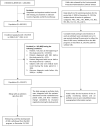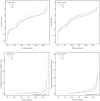Long-term ambient hydrocarbon exposure and incidence of urinary bladder cancer
- PMID: 36460770
- PMCID: PMC9718740
- DOI: 10.1038/s41598-022-25425-6
Long-term ambient hydrocarbon exposure and incidence of urinary bladder cancer
Abstract
Particulate matter and volatile organic compounds, including total hydrocarbons (THCs), are major ambient air pollutants. Primary nonmethane hydrocarbons (NMHCs) originate from vehicle emissions. The association between air pollution and urinary bladder cancer (UBC) is debatable. We investigated whether long-term exposure to ambient hydrocarbons increases UBC risk among people aged ≥ 20 years in Taiwan. Linkage dataset research with longitudinal design was conducted among 589,135 initially cancer-free individuals during 2000-2013; 12 airborne pollutants were identified. Several Cox models considering potential confounders were employed. The study outcomes were invasive or in situ UBC incidence over time. The targeted pollutant concentration was divided into three tertiles: T1/T2/T3. The mean age of individuals at risk was 42.5 (SD 15.7), and 50.5% of the individuals were men. The mean daily average over 10 years of airborne THC concentration was 2.25 ppm (SD 0.13), and NMHC was 0.29 ppm (SD 0.09). Both pollutants show long-term monotonic downward trend over time using the Mann-Kendall test. There was a dose-dependent increase in UBC at follow-up. UBC incidence per 100,000 enrollees according to T1/T2/T3 exposure to THC was 60.9, 221.2, and 651.8, respectively; it was 170.0/349.5/426.7 per 100,000 enrollees, corresponding to T1/T2/T3 exposure to NMHC, respectively. Without controlling for confounding air pollutants, the adjusted hazard ratio (adj.HR) was 1.83 (95% CI 1.75-1.91) per 0.13-ppm increase in THC; after controlling for PM2.5, adj.HR was even higher at 2.09 (95% CI 1.99-2.19). The adj.HR was 1.37 (95% CI 1.32-1.43) per 0.09-ppm increase in ambient NMHC concentration. After controlling for SO2 and CH4, the adj.HR was 1.10 (95% CI 1.06-1.15). Sensitivity analyses showed that UBC development risk was not sex-specific or influenced by diabetes status. Long-term exposure to THC and NMHC may be a risk factor for UBC development. Acknowledging pollutant sources can inform risk management strategies.
© 2022. The Author(s).
Conflict of interest statement
Han-Wei Zhang, Hsiao-Ching Peng reports equipment and statistical analysis were provided by Biomedica Corporation. Han-Wei Zhang reports a relationship with Biomedica Corporation in the form of board membership. Hsiao-Ching Peng reports a relationship with Biomedica Corporation in the form of employment. Both received support for using the product ‘MetaTrial Platform’ to conduct the present research. Both declare that they had full access to all the data in this study and take complete responsibility for the integrity of the data and the accuracy of the data analysis. The other authors declare that they have no competing interests.
Figures



Similar articles
-
Long-term ambient hydrocarbons exposure and incidence of ischemic stroke.PLoS One. 2019 Dec 4;14(12):e0225363. doi: 10.1371/journal.pone.0225363. eCollection 2019. PLoS One. 2019. PMID: 31800599 Free PMC article.
-
Incidence of retinal vein occlusion with long-term exposure to ambient air pollution.PLoS One. 2019 Sep 24;14(9):e0222895. doi: 10.1371/journal.pone.0222895. eCollection 2019. PLoS One. 2019. PMID: 31550294 Free PMC article.
-
Effects of long-term exposure to traffic-related air pollution on respiratory and cardiovascular mortality in the Netherlands: the NLCS-AIR study.Res Rep Health Eff Inst. 2009 Mar;(139):5-71; discussion 73-89. Res Rep Health Eff Inst. 2009. PMID: 19554969
-
Association between exposure to ambient air pollution and hospital admission, incidence, and mortality of stroke: an updated systematic review and meta-analysis of more than 23 million participants.Environ Health Prev Med. 2021 Jan 26;26(1):15. doi: 10.1186/s12199-021-00937-1. Environ Health Prev Med. 2021. PMID: 33499804 Free PMC article.
-
Risk Factors Associated with Urothelial Bladder Cancer.Int J Environ Res Public Health. 2024 Jul 22;21(7):954. doi: 10.3390/ijerph21070954. Int J Environ Res Public Health. 2024. PMID: 39063530 Free PMC article. Review.
Cited by
-
Treatment Patterns and Radical Cystectomy Outcomes in Patients Diagnosed With Urothelial Nonmetastatic Muscle-Invasive Bladder Cancer in the United States.Cancer Med. 2025 Feb;14(4):e70644. doi: 10.1002/cam4.70644. Cancer Med. 2025. PMID: 39945337 Free PMC article.
-
Bladder Cancer in Lebanon: An Updated Epidemiological Comparison with Global Regions and a Comprehensive Review of Risk Factors.Cancer Control. 2025 Jan-Dec;32:10732748251330696. doi: 10.1177/10732748251330696. Epub 2025 Apr 1. Cancer Control. 2025. PMID: 40170215 Free PMC article. Review.
-
Bladder Cancer Carcinogens: Opportunities for Risk Reduction.Eur Urol Focus. 2023 Jul;9(4):575-578. doi: 10.1016/j.euf.2023.03.017. Epub 2023 Apr 5. Eur Urol Focus. 2023. PMID: 37028984 Free PMC article. Review.
References
Publication types
MeSH terms
Substances
LinkOut - more resources
Full Text Sources
Medical

